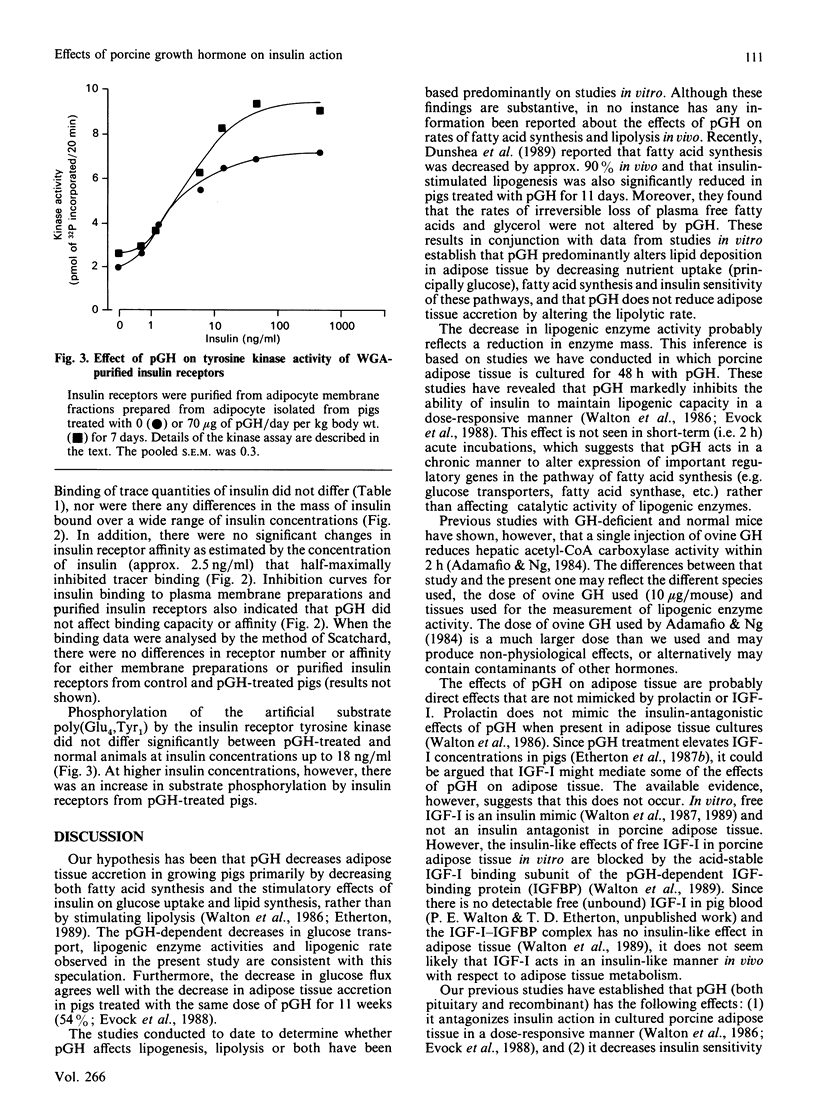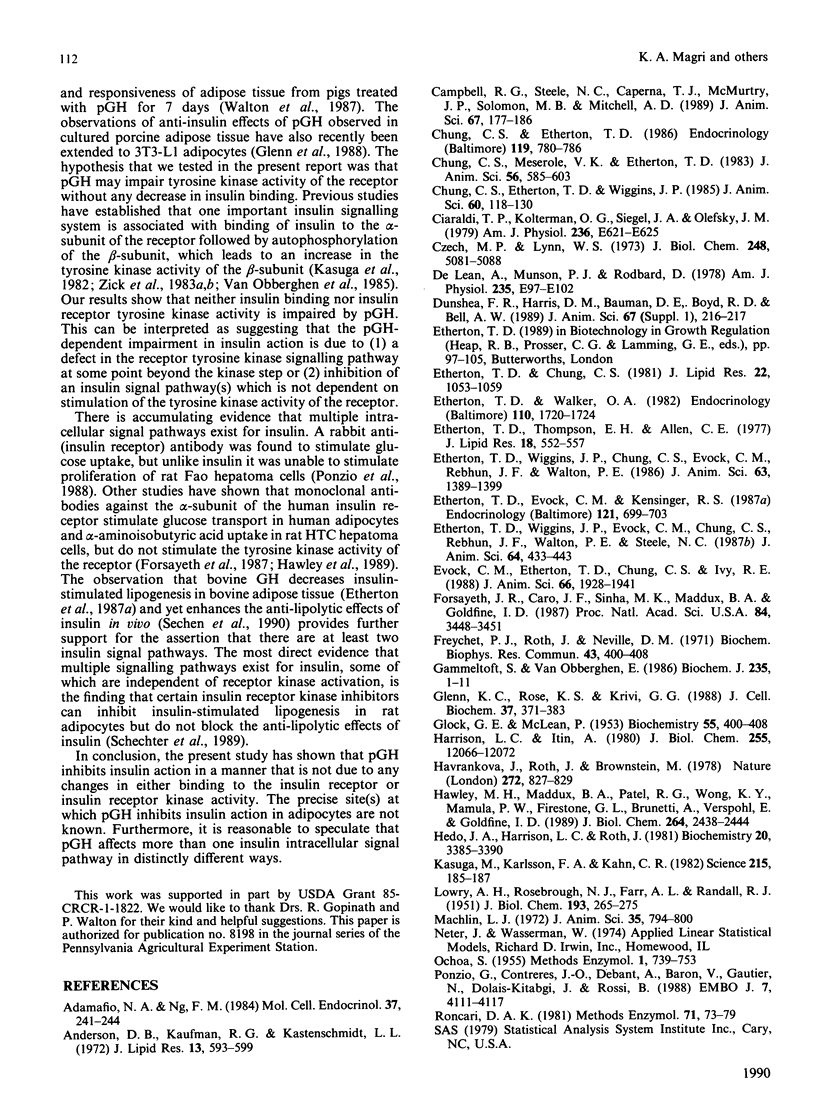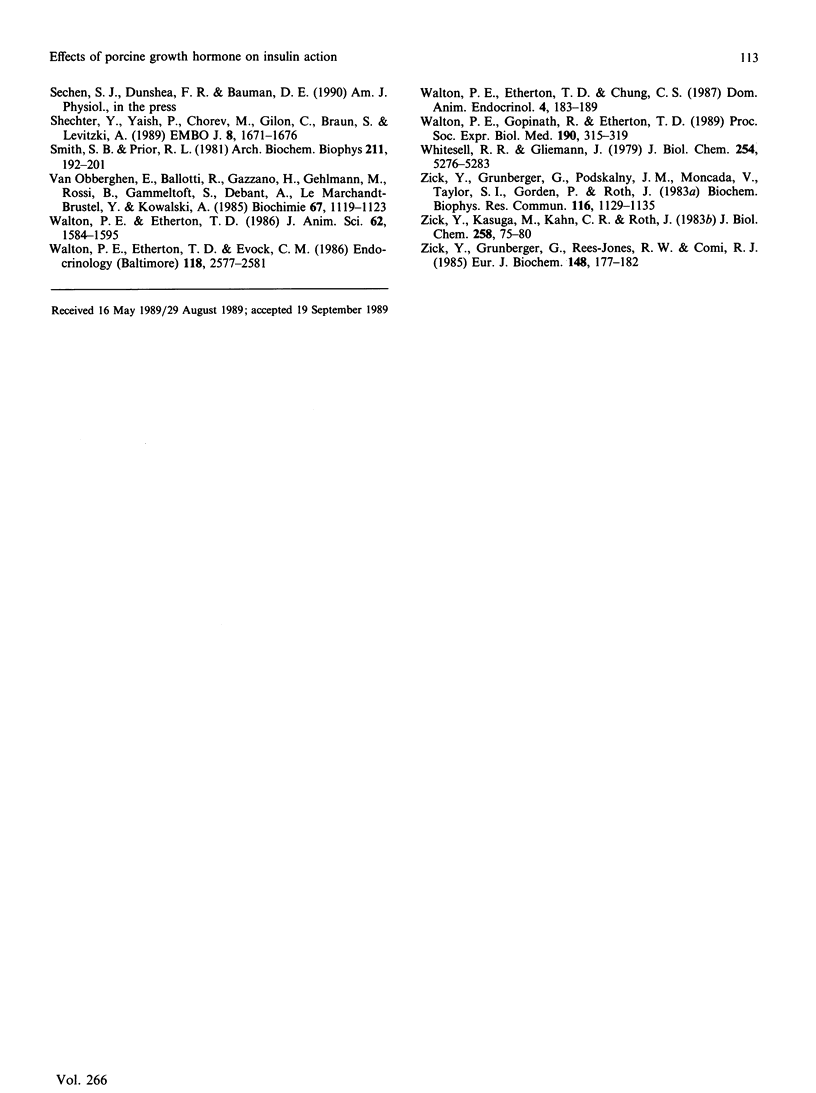Abstract
The present study was undertaken to determine the effects of porcine growth hormone (pGH) on glucose transport, to establish which lipogenic enzymes were affected by pGH, and to determine if changes in insulin binding or insulin receptor kinase activity contributed to the diminished insulin responsiveness of adipocytes from pigs treated with pGH. Pigs were treated with pGH daily (70 micrograms/kg body wt.) for 7 days. pGH treatment reduced the basal (non-insulin-stimulated) glucose transport rate by 62% and the insulin-stimulated transport rate by 47%. The decline in glucose transport rate was paralleled by a 64% decrease in fatty acid synthesis. The reduction in the lipogenic rate was associated with a marked decline in the activity of several lipogenic enzymes: glucose-6-phosphate dehydrogenase (50% decrease), 6-phosphogluconate dehydrogenase (11% decrease), malic enzyme (62% decrease) and fatty acid synthase (activity not detectable after pGH treatment). The pGH-dependent decline in insulin responsiveness was not associated with any change in the binding of insulin to intact adipocytes or to plasma membrane preparations. The insulin-stimulated tyrosine kinase activity of the wheat-germ agglutinin-purified receptors from pGH-treated adipocytes was not different from that in control adipocytes, except when high concentrations of insulin were employed. These findings establish that pGH elicits a number of metabolic effects in porcine adipocytes which collectively diminish the rate of lipid synthesis, and thereby contribute to the decrease in lipid deposition observed in pGH-treated pigs. Furthermore, the pGH-dependent impairment in insulin action appears to be mediated at some location distal to the receptor kinase step or in other signal pathway(s) which mediate the biological effects of insulin that are not dependent on activation of insulin receptor tyrosine kinase activity.
Full text
PDF






Selected References
These references are in PubMed. This may not be the complete list of references from this article.
- Adamafio N. A., Ng F. M. Effects of growth hormone on lipogenesis and glucose oxidation in genetically GH-deficient mice. Mol Cell Endocrinol. 1984 Sep;37(2):241–244. doi: 10.1016/0303-7207(84)90057-1. [DOI] [PubMed] [Google Scholar]
- Anderson D. B., Kauffman R. G., Kastenschmidt L. L. Lipogenic enzyme activities and cellularity of porcine adipose tissue from various anatomical locations. J Lipid Res. 1972 Sep;13(5):593–599. [PubMed] [Google Scholar]
- Campbell R. G., Steele N. C., Caperna T. J., McMurtry J. P., Solomon M. B., Mitchell A. D. Interrelationships between sex and exogenous growth hormone administration on performance, body composition and protein and fat accretion of growing pigs. J Anim Sci. 1989 Jan;67(1):177–186. doi: 10.2527/jas1989.671177x. [DOI] [PubMed] [Google Scholar]
- Chung C. S., Etherton T. D. Characterization of porcine growth hormone (pGH) binding to porcine liver microsomes: chronic administration of pGH induces pGH binding. Endocrinology. 1986 Aug;119(2):780–786. doi: 10.1210/endo-119-2-780. [DOI] [PubMed] [Google Scholar]
- Chung C. S., Etherton T. D., Wiggins J. P. Stimulation of swine growth by porcine growth hormone. J Anim Sci. 1985 Jan;60(1):118–130. doi: 10.2527/jas1985.601118x. [DOI] [PubMed] [Google Scholar]
- Ciaraldi T. P., Kolterman O. G., Siegel J. A., Olefsky J. M. Insulin-stimulated glucose transport in human adipocytes. Am J Physiol. 1979 Jun;236(6):E621–E625. doi: 10.1152/ajpendo.1979.236.6.E621. [DOI] [PubMed] [Google Scholar]
- Czech M. P., Lynn W. S. The plasma membrane of isolated fat cells. I. Identification of trypsin-sensitive membrane peptides by sodium dodecyl sulfate polyacrylamide gel electrophoresis. J Biol Chem. 1973 Jul 25;248(14):5081–5088. [PubMed] [Google Scholar]
- DeLean A., Munson P. J., Rodbard D. Simultaneous analysis of families of sigmoidal curves: application to bioassay, radioligand assay, and physiological dose-response curves. Am J Physiol. 1978 Aug;235(2):E97–102. doi: 10.1152/ajpendo.1978.235.2.E97. [DOI] [PubMed] [Google Scholar]
- Etherton T. D., Chung C. S. Preparation, characterization, and insulin sensitivity of isolated swine adipocytes: comparison with adipose tissue slices. J Lipid Res. 1981 Sep;22(7):1053–1059. [PubMed] [Google Scholar]
- Etherton T. D., Evock C. M., Kensinger R. S. Native and recombinant bovine growth hormone antagonize insulin action in cultured bovine adipose tissue. Endocrinology. 1987 Aug;121(2):699–703. doi: 10.1210/endo-121-2-699. [DOI] [PubMed] [Google Scholar]
- Etherton T. D., Thompson E. H., Allen C. E. Improved techniques for studies of adipocyte cellularity and metabolism. J Lipid Res. 1977 Jul;18(4):552–557. [PubMed] [Google Scholar]
- Etherton T. D., Walker O. A. Characterization of insulin binding to isolated swine adipocytes. Endocrinology. 1982 May;110(5):1720–1724. doi: 10.1210/endo-110-5-1720. [DOI] [PubMed] [Google Scholar]
- Etherton T. D., Wiggins J. P., Chung C. S., Evock C. M., Rebhun J. F., Walton P. E. Stimulation of pig growth performance by porcine growth hormone and growth hormone-releasing factor. J Anim Sci. 1986 Nov;63(5):1389–1399. doi: 10.2527/jas1986.6351389x. [DOI] [PubMed] [Google Scholar]
- Etherton T. D., Wiggins J. P., Evock C. M., Chung C. S., Rebhun J. F., Walton P. E., Steele N. C. Stimulation of pig growth performance by porcine growth hormone: determination of the dose-response relationship. J Anim Sci. 1987 Feb;64(2):433–443. doi: 10.2527/jas1987.642433x. [DOI] [PubMed] [Google Scholar]
- Evock C. M., Etherton T. D., Chung C. S., Ivy R. E. Pituitary porcine growth hormone (pGH) and a recombinant pGH analog stimulate pig growth performance in a similar manner. J Anim Sci. 1988 Aug;66(8):1928–1941. doi: 10.2527/jas1988.6681928x. [DOI] [PubMed] [Google Scholar]
- Forsayeth J. R., Caro J. F., Sinha M. K., Maddux B. A., Goldfine I. D. Monoclonal antibodies to the human insulin receptor that activate glucose transport but not insulin receptor kinase activity. Proc Natl Acad Sci U S A. 1987 May;84(10):3448–3451. doi: 10.1073/pnas.84.10.3448. [DOI] [PMC free article] [PubMed] [Google Scholar]
- Freychet P., Roth J., Neville D. M., Jr Monoiodoinsulin: demonstration of its biological activity and binding to fat cells and liver membranes. Biochem Biophys Res Commun. 1971 Apr 16;43(2):400–408. doi: 10.1016/0006-291x(71)90767-4. [DOI] [PubMed] [Google Scholar]
- GLOCK G. E., McLEAN P. Further studies on the properties and assay of glucose 6-phosphate dehydrogenase and 6-phosphogluconate dehydrogenase of rat liver. Biochem J. 1953 Oct;55(3):400–408. doi: 10.1042/bj0550400. [DOI] [PMC free article] [PubMed] [Google Scholar]
- Gammeltoft S., Van Obberghen E. Protein kinase activity of the insulin receptor. Biochem J. 1986 Apr 1;235(1):1–11. doi: 10.1042/bj2350001. [DOI] [PMC free article] [PubMed] [Google Scholar]
- Glenn K. C., Rose K. S., Krivi G. G. Somatotropin antagonism of insulin-stimulated glucose utilization in 3T3-L1 adipocytes. J Cell Biochem. 1988 Aug;37(4):371–383. doi: 10.1002/jcb.240370405. [DOI] [PubMed] [Google Scholar]
- Harrison L. C., Itin A. Purification of the insulin receptor from human placenta by chromatography on immobilized wheat germ lectin and receptor antibody. J Biol Chem. 1980 Dec 25;255(24):12066–12072. [PubMed] [Google Scholar]
- Havrankova J., Roth J., Brownstein M. Insulin receptors are widely distributed in the central nervous system of the rat. Nature. 1978 Apr 27;272(5656):827–829. doi: 10.1038/272827a0. [DOI] [PubMed] [Google Scholar]
- Hawley D. M., Maddux B. A., Patel R. G., Wong K. Y., Mamula P. W., Firestone G. L., Brunetti A., Verspohl E., Goldfine I. D. Insulin receptor monoclonal antibodies that mimic insulin action without activating tyrosine kinase. J Biol Chem. 1989 Feb 15;264(5):2438–2444. [PubMed] [Google Scholar]
- Hedo J. A., Harrison L. C., Roth J. Binding of insulin receptors to lectins: evidence for common carbohydrate determinants on several membrane receptors. Biochemistry. 1981 Jun 9;20(12):3385–3393. doi: 10.1021/bi00515a013. [DOI] [PubMed] [Google Scholar]
- Kasuga M., Karlsson F. A., Kahn C. R. Insulin stimulates the phosphorylation of the 95,000-dalton subunit of its own receptor. Science. 1982 Jan 8;215(4529):185–187. doi: 10.1126/science.7031900. [DOI] [PubMed] [Google Scholar]
- LOWRY O. H., ROSEBROUGH N. J., FARR A. L., RANDALL R. J. Protein measurement with the Folin phenol reagent. J Biol Chem. 1951 Nov;193(1):265–275. [PubMed] [Google Scholar]
- Machlin L. J. Effect of porcine growth hormone on growth and carcass composition of the pig. J Anim Sci. 1972 Oct;35(4):794–800. doi: 10.2527/jas1972.354794x. [DOI] [PubMed] [Google Scholar]
- Ponzio G., Contreres J. O., Debant A., Baron V., Gautier N., Dolais-Kitabgi J., Rossi B. Use of an anti-insulin receptor antibody to discriminate between metabolic and mitogenic effects of insulin: correlation with receptor autophosphorylation. EMBO J. 1988 Dec 20;7(13):4111–4117. doi: 10.1002/j.1460-2075.1988.tb03305.x. [DOI] [PMC free article] [PubMed] [Google Scholar]
- Roncari D. A. Fatty acid synthase from human liver. Methods Enzymol. 1981;71(Pt 100):73–79. doi: 10.1016/0076-6879(81)71011-5. [DOI] [PubMed] [Google Scholar]
- Shechter Y., Yaish P., Chorev M., Gilon C., Braun S., Levitzki A. Inhibition of insulin-dependent lipogenesis and anti-lipolysis by protein tyrosine kinase inhibitors. EMBO J. 1989 Jun;8(6):1671–1676. doi: 10.1002/j.1460-2075.1989.tb03558.x. [DOI] [PMC free article] [PubMed] [Google Scholar]
- Smith S. B., Prior R. L. Evidence for a functional ATP-citrate lyase:NADP-malate dehydrogenase pathway in bovine adipose tissue: enzyme and metabolite levels. Arch Biochem Biophys. 1981 Oct 1;211(1):192–201. doi: 10.1016/0003-9861(81)90444-6. [DOI] [PubMed] [Google Scholar]
- Van Obberghen E., Ballotti R., Gazzano H., Fehlmann M., Rossi B., Gammeltoft S., Debant A., Le Marchand-Brustel Y., Kowalski A. The insulin receptor kinase. Biochimie. 1985 Oct-Nov;67(10-11):1119–1124. doi: 10.1016/s0300-9084(85)80109-7. [DOI] [PubMed] [Google Scholar]
- Walton P. E., Etherton T. D., Chung C. S. Exogenous pituitary and recombinant growth hormones induce insulin and insulin-like growth factor 1 resistance in pig adipose tissue. Domest Anim Endocrinol. 1987 Jul;4(3):183–189. doi: 10.1016/0739-7240(87)90014-2. [DOI] [PubMed] [Google Scholar]
- Walton P. E., Etherton T. D., Evock C. M. Antagonism of insulin action in cultured pig adipose tissue by pituitary and recombinant porcine growth hormone: potentiation by hydrocortisone. Endocrinology. 1986 Jun;118(6):2577–2581. doi: 10.1210/endo-118-6-2577. [DOI] [PubMed] [Google Scholar]
- Walton P. E., Etherton T. D. Stimulation of lipogenesis by insulin in swine adipose tissue: antagonism by porcine growth hormone. J Anim Sci. 1986 Jun;62(6):1584–1595. doi: 10.2527/jas1986.6261584x. [DOI] [PubMed] [Google Scholar]
- Walton P. E., Gopinath R., Etherton T. D. Porcine insulin-like growth factor (IGF) binding protein blocks IGF-I action on porcine adipose tissue. Proc Soc Exp Biol Med. 1989 Apr;190(4):315–319. doi: 10.3181/00379727-190-42865. [DOI] [PubMed] [Google Scholar]
- Whitesell R. R., Gliemann J. Kinetic parameters of transport of 3-O-methylglucose and glucose in adipocytes. J Biol Chem. 1979 Jun 25;254(12):5276–5283. [PubMed] [Google Scholar]
- Zick Y., Grunberger G., Podskalny J. M., Moncada V., Taylor S. I., Gorden P., Roth J. Insulin stimulates phosphorylation of serine residues in soluble insulin receptors. Biochem Biophys Res Commun. 1983 Nov 15;116(3):1129–1135. doi: 10.1016/s0006-291x(83)80260-5. [DOI] [PubMed] [Google Scholar]
- Zick Y., Grunberger G., Rees-Jones R. W., Comi R. J. Use of tyrosine-containing polymers to characterize the substrate specificity of insulin and other hormone-stimulated tyrosine kinases. Eur J Biochem. 1985 Apr 1;148(1):177–182. doi: 10.1111/j.1432-1033.1985.tb08822.x. [DOI] [PubMed] [Google Scholar]
- Zick Y., Kasuga M., Kahn C. R., Roth J. Characterization of insulin-mediated phosphorylation of the insulin receptor in a cell-free system. J Biol Chem. 1983 Jan 10;258(1):75–80. [PubMed] [Google Scholar]


